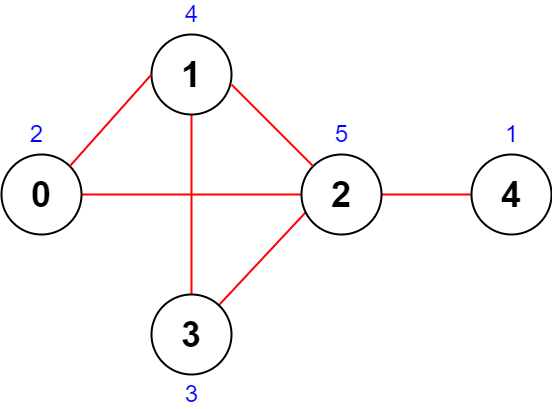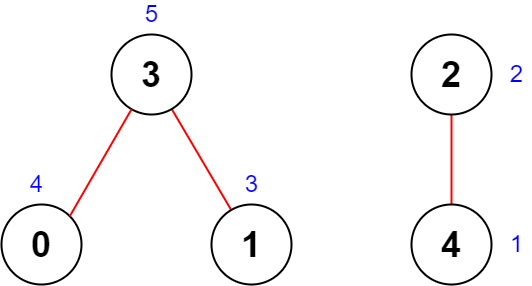-
LeetCode每日一题(2285. Maximum Total Importance of Roads)
You are given an integer n denoting the number of cities in a country. The cities are numbered from 0 to n - 1.
You are also given a 2D integer array roads where roads[i] = [ai, bi] denotes that there exists a bidirectional road connecting cities ai and bi.
You need to assign each city with an integer value from 1 to n, where each value can only be used once. The importance of a road is then defined as the sum of the values of the two cities it connects.
Return the maximum total importance of all roads possible after assigning the values optimally.
Example 1:

Input: n = 5, roads = [[0,1],[1,2],[2,3],[0,2],[1,3],[2,4]]
Output: 43Explanation: The figure above shows the country and the assigned values of [2,4,5,3,1].
- The road (0,1) has an importance of 2 + 4 = 6.
- The road (1,2) has an importance of 4 + 5 = 9.
- The road (2,3) has an importance of 5 + 3 = 8.
- The road (0,2) has an importance of 2 + 5 = 7.
- The road (1,3) has an importance of 4 + 3 = 7.
- The road (2,4) has an importance of 5 + 1 = 6.
The total importance of all roads is 6 + 9 + 8 + 7 + 7 + 6 = 43.
It can be shown that we cannot obtain a greater total importance than 43.
Example 2:

Input: n = 5, roads = [[0,3],[2,4],[1,3]]
Output: 20Explanation: The figure above shows the country and the assigned values of [4,3,2,5,1].
- The road (0,3) has an importance of 4 + 5 = 9.
- The road (2,4) has an importance of 2 + 1 = 3.
- The road (1,3) has an importance of 3 + 5 = 8.
The total importance of all roads is 9 + 3 + 8 = 20.
It can be shown that we cannot obtain a greater total importance than 20.
Constraints:
- 2 <= n <= 5 * 104
- 1 <= roads.length <= 5 * 104
- roads[i].length == 2
- 0 <= ai, bi <= n - 1
- ai != bi
- There are no duplicate roads.
每个节点能为最终答案贡献 m * v 的 importance, m 代表与此节点连接的路的数量, v 代表的赋予此节点的值, 这样我们不难看出, 我们应该给 m 较大的节点赋予较大的值, 所以我们只需要统计每个节点锁连接的路的数量, 然后根据路的数量排序, 然后按顺序赋值求和就可以了
impl Solution { pub fn maximum_importance(n: i32, roads: Vec<Vec<i32>>) -> i64 { let mut counts = vec![0; n as usize]; for road in roads { counts[road[0] as usize] += 1; counts[road[1] as usize] += 1; } counts.sort(); counts .into_iter() .enumerate() .map(|(i, v)| v as i64 * (i as i64 + 1)) .sum() } }- 1
- 2
- 3
- 4
- 5
- 6
- 7
- 8
- 9
- 10
- 11
- 12
- 13
- 14
- 15
-
相关阅读:
Mac/Wins Matlab如何查看APPs源码
20240309web前端_第四次作业_完成随机点名程序
【花书笔记|PyTorch版】手动学深度学习303: 线性神经模型:代码部分(下)
ansible的主机清单和Playbook(剧本)
2022阿里云金秋上云双十一轻量服务器2核2G 2核4G
常见的缺陷管理工具——禅道,从安装到使用手把手教会你
Java for each循环语句的功能简介说明
Linux内核源码分析 (B.3) 深入理解 Linux 物理内存分配全链路实现
【英语语法】but
Spring 中不得不了解的姿势
- 原文地址:https://blog.csdn.net/wangjun861205/article/details/126134132